 The day the sky cracked in half.  
There's been increased talk over the last few years about the weaponization of space, however that bridge was crossed a long, long time ago by the U.S. and Soviet Union, with the U.S. getting the ball rolling in 1958 with a series of tests secretly conducted over the South Atlantic Ocean. The above photos, which were made from Honolulu, Hawaii, and the one below made from a surveillance aircraft, and show the U.S. nuclear test known as Starfish Prime. It was one of five explosions comprising Operation Fishbowl, which itself was folded within the encompassing set of tests known as Operation Dominic. The detonation took place in space at an altitude of about 250 miles, and was launched from the North Pacific Ocean's Johnston Atoll atop a Thor ballistic missile. That was today in 1962.
 1-2-0-0, party over, oops out of time. So tonight we're gonna party like it's 11:59. 
The Doomsday Clock is currently set at ninety seconds to midnight. That's not good. Here in the palatial Pulp Intl. metroplex we tend not to worry too much. For one, we're too focused on enjoying life. Second, we've always maintained that the only possible benefit to the ridiculous proliferation of the ultra wealthy is that none of them want to be incinerated, and they possibly have influence on countries' policies to a greater extent than at any previous time in history. On the other hand, humans are generally pretty stupid, running geopolitics like high school bullies, and there are many people who crave obliteration because of their bronze age religious myths. Some of those people are influential too.
So, in these moments when the spinning top of human civilization threatens to careen right off the tiny table on which it's perched, the above photo is a reminder to live your life to the fullest. It shows the nuclear test Grable, which was part of the series of tests nicknamed Operation Upshot-Knothole, and occurred at the Nevada Test Site today in 1953. They fired a 280 millimeter nuclear shell into the desert with the so-named M65 Atomic Cannon, detonating the explosive aerially, resulting in a 15 kiloton blast. And they proved... Well, we can't be sure about that. Multiple methods of doomsday delivery, possible delusions about contained nuclear warfare, etc. Dance, everyone. Just dance. 
 Mid-century sex symbol provides inspiration for nuclear erotica. 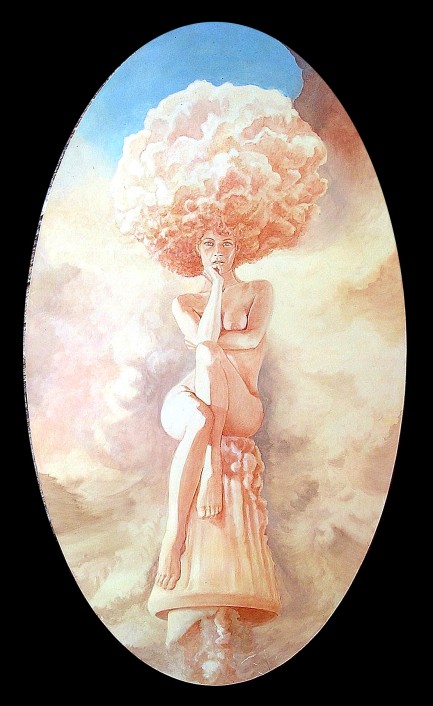
This unusual piece of art was made by a French artist named Jacques Puiseux, whose work we've shared here before. We happened to be in contact with him recently, and he sent this our way to enjoy. He painted it back in 1999, and it suggests Brigitte Bardot and the French nuclear tests at Mururoa Atoll, combined to create “a graphic pun of a sex bomb.” Appropriately, he calls it “Vénus Atomica.” We dig it, and Jacques' other art too, which you can see by clicking his keywords below. Just a little something different for you this lovely Thursday. Also, Jacques has a Flickr gallery here.
 Hey, should we put another log or two on the— Actually, never mind. It's going pretty good now. 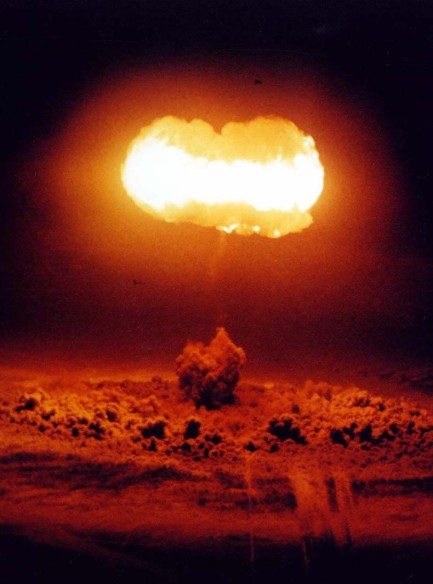
The Stokes nuclear test was part of the extensive series of blasts code-named Operation Plumbbob conducted at the Nevada Test Site, as the U.S. continued its race with the Soviet Union, seeking higher yielding, more efficient, and more specifically functional bombs. Stokes was a nineteen kiloton blast detonated with the use of an aerial balloon suspended at 1,500 feet. The result was one of the most reproduced photos of the nuclear testing age. From today in 1957.
 It's a type of animal to which the normal rules of logic don't seem to apply. 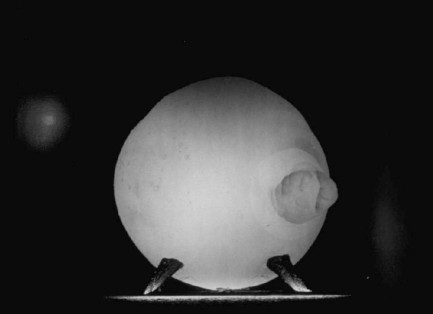
Above is a photo of the nuclear test Mohawk, part of a seventeen blast series designated Redwing. The 360 kiloton Mohawk took place on Enewetak or Eniwetok Atoll. The first few milliseconds of a nuclear blast tend to produce forms like the one seen here, a bulbous shape with vaporizing guy wires that resemble stubby legs. To us, these shapes look a bit like tardigrades, those microscopic life forms found everywhere on Earth from jungle to arctic to sea bottom, and which are so resilient and difficult to kill they can survive extreme high and low pressures, radiation, dehydration, starvation, and exposure to the vacuum of space.
Similarly, nuclear weapons seem able to survive anything, though their existence is proof of the folly of man. While we can certainly accept that we aren't an intelligent enough species to forgo the creation of armageddon causing weapons, the U.S. and Russia both have more than 5,000 nukes, an amount at which balance of power becomes meaningless. Weapon 4,999 is not the one that makes a nation secure. Nor is weapon 999. Military sources claim missile interception systems work at a rate of 80%, while arms control advocates say the real number is closer to 50%. In either case, in a full scale nuclear exchange hundreds of nukes would reach their targets.
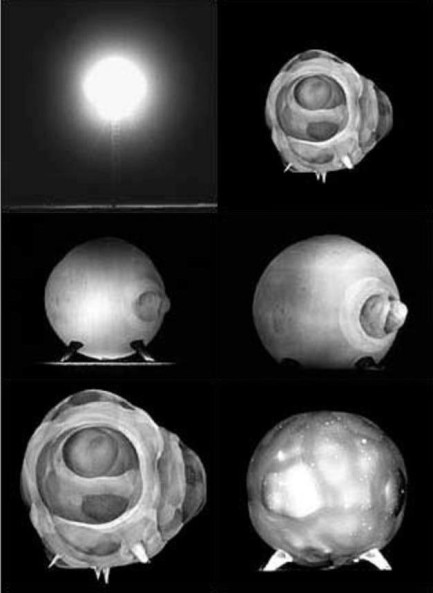
 Rule No. 1 of military service: Never volunteer. 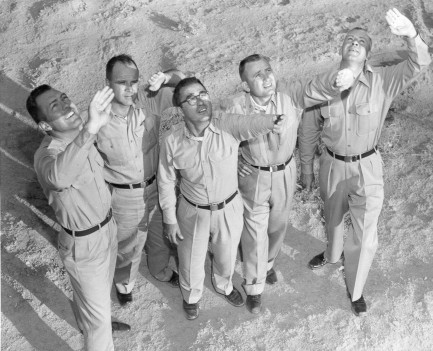
The moment you see this photo you know something bizarre and unique to the 1950s is going on. In what was conceived by Air Force brains as a public relations event, today in 1957 these five men (and the photographer) voluntarily located themselves beneath a nuclear detonation to demonstrate that atomic weapons were suitable for use over civilian populations. Yes, we know—if they don't kill people what's the point? Like we said, bizarre and unique to the ’50s. The U.S. would later design a neutron bomb that was 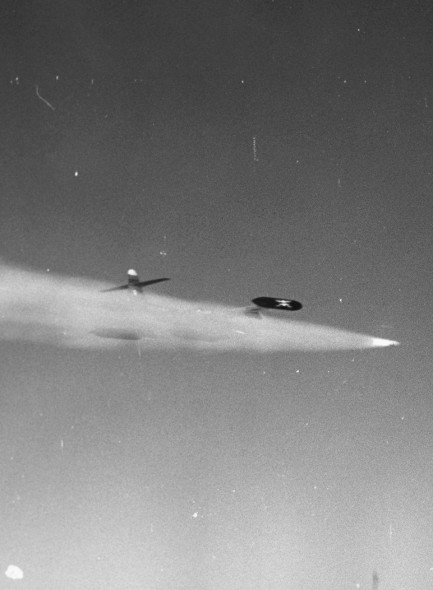 meant to kill only people and leave buildings and infrastructure intact, which makes sense in upside-down military world, but not killing people? We're baffled. meant to kill only people and leave buildings and infrastructure intact, which makes sense in upside-down military world, but not killing people? We're baffled.
The explosion, which was code-named John, was part of the Operation Plumbbob series of twenty-nine tests, and took place over Yucca Flat in Nevada at an altitude of 18,000 feet or thereabouts (some sources say 15,000). It was the first and only usage of a device known as the AIR-2 Genie, an airplane launched, rocket powered, unguided nuclear missile. We have no problem admitting they would have lost us at unguided. We wouldn't even be in the same time zone: “Okay, everyone ready? Good, we're counting down from— Hey, where'd those pulp guys go?” Did the test actually prove nuclear weapons were safe? They thought so. All five of the above guinea pigs lived for years beyond detonation day, but in a (not) shocking plot twist, all eventually died of cancer. The photographer, who was stationed a few feet higher than the other men, was incinerated. Oh, nope—actually he died of cancer too. You can watch the test at this link.
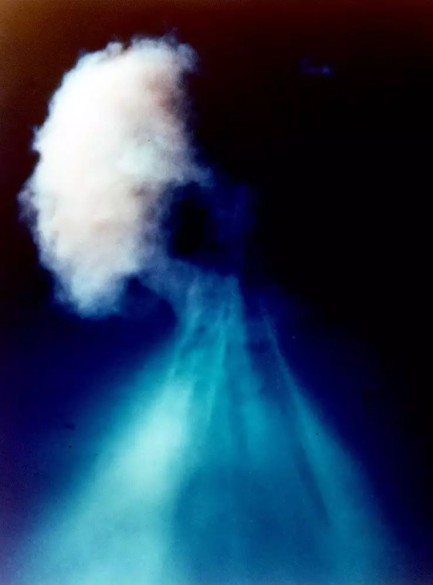
 The greatest trick he ever pulled was convincing the world he was national defense. 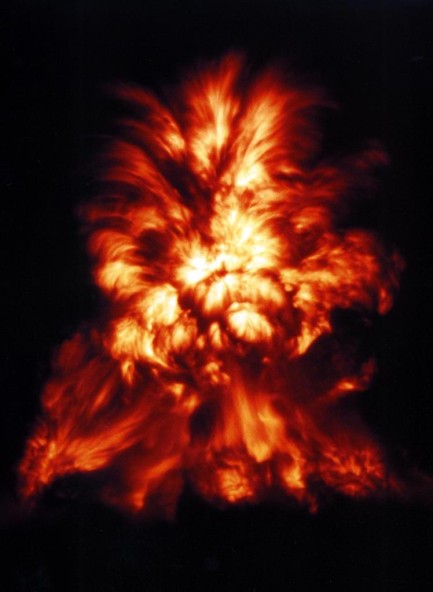
Are we still here? We haven't been reduced to incandescent plasma yet? We're continually amazed by that fact. But let's never be complacent. The danger is ever-present. As we've mentioned before, nuclear weapons are part of the unseen—or sometimes seen—backdrop to a fair amount of mid-century crime literature and at least one celebrated film noir, which is why we periodically focus on them. Above is one of the most manifestly revealing nuclear test photos ever made. It was produced today in 1952 during a blast code-named Fox, and captures the essence of what atomic weapons really are—a demonic force unleashed that can't be shoved back into its pit.
 Not only was she explosively sexy, but her voice could blow you away. 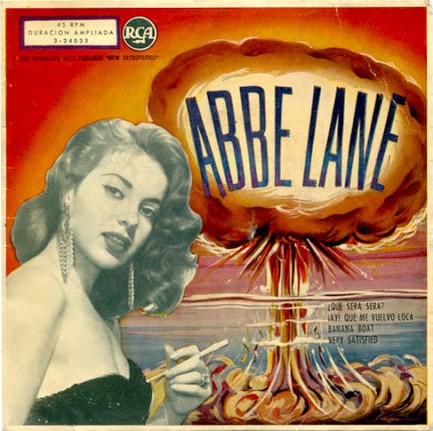
We love this nuclear themed 45 sleeve for an Abbe Lane four song disc, which we guess is titled simply Abbe Lane. It came from RCA Española and was released in Spain in 1958 with the offerings: “Que será será,” “¡Ay! Que Me Vuelvo Loca,” “Banana Boat (Day-O),” and “Very Satisfied.” All four songs are easy to sample online, so give them a whirl if you wish.
The rear sleeve text is fun. It says: Abbe Lane is without a doubt one of the most popular and applauded voices of the current musical moment. All her performances are hits and the songs she sings come to us covered in a rhythm and color that make them even more seductive.
Without a doubt, the secret of her success lies in herself, in her warm voice, in her exquisite way of conveying the message of her music to the listener, in her magnetic figure and great physical attractiveness.
In this recording, Abbe Lane sings in English and Spanish, interprets two calypsos, a fashionable rhythm that has come to dispute the primacy enjoyed by the much-discussed “rock and roll,” and two melodies that will be popular through the warm voice of the artist pampered by the public and critics worldwide: Abbe Lane.
The promotional staff at RCA Española might have loved Lane, but they couldn't spell. They open the third paragraph by calling her “Abre,” instead of Abbe. That amused us. We also like how, according to the front office brains, calypso was supplanting rock and roll. Really? Well, it turned out to be a marathon, not a sprint. We have a bonus shot of Lane below, for your viewing pleasure.
 For there were no more worlds to conquer. 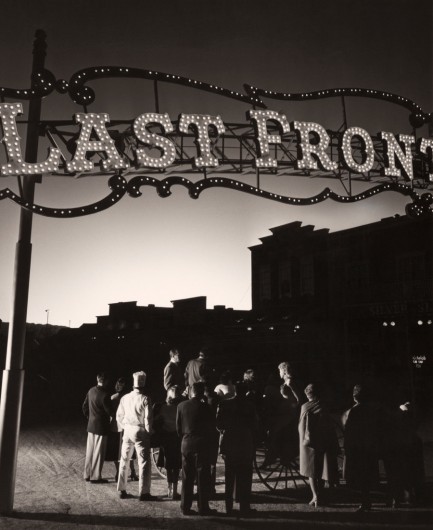
Above: a crowd of spectators standing under the entrance sign of the Last Frontier Village on the Las Vegas strip watch the flash from a nuclear blast emanating from the Nevada desert. In the immediate background are Old West-style buildings that housed shops, restaurants, and the Golden Slipper Casino. The sign is a nice juxtaposition by lensman Volkmar Wentzel, placing his shot at the nexus of visual metaphor and social commentary. The bomb, named Annie, was detonated at Yucca Flat at the Nevada Test Site as part of the test series Operation Upshot-Knothole. It was one of the most photographed of nuclear tests, which is why we've already touched on it here and here, and in fact, because the event was even documented on kinescope, it's one of the few recordings ever made of the sound of a nuclear explosion. Below you see what Annie looked like for people closer to ground zero. It happened early this morning in 1953.
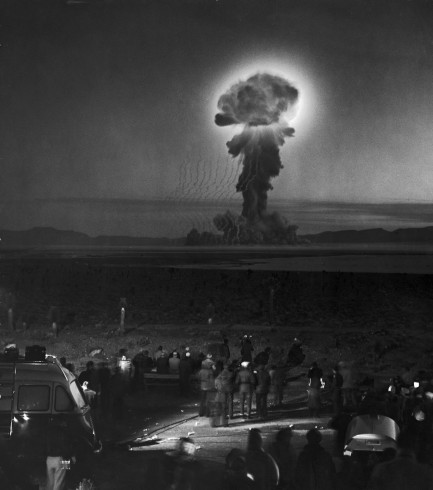
 The decline and incineration of Western civilization. 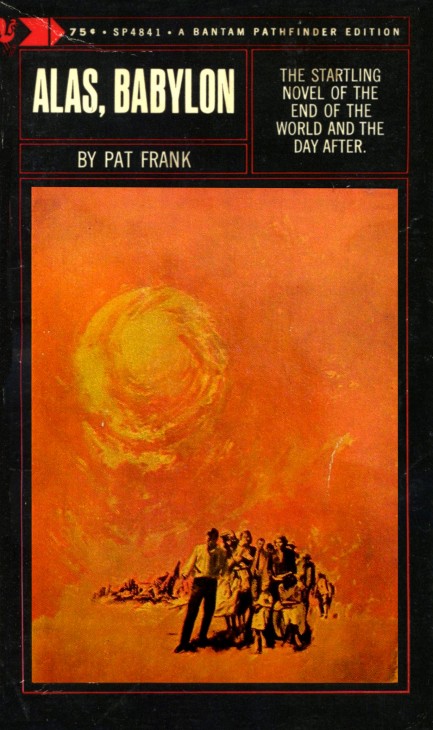 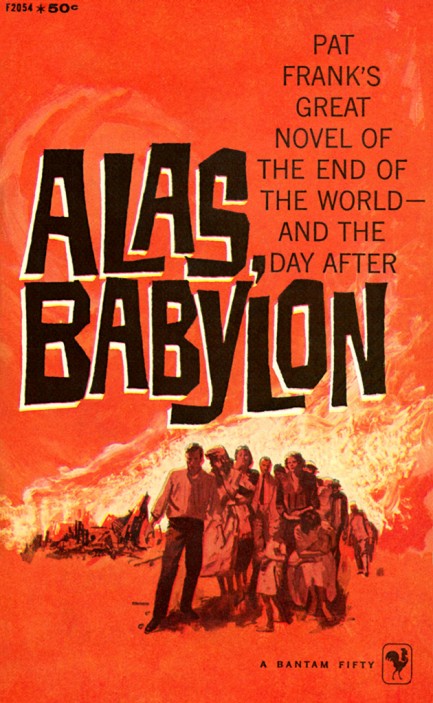 
These covers for Pat Frank's acclaimed post apocalypse drama Alas, Babylon can be considered additions to our collection of nuclear explosion book covers. In the story, a missile from a fighter jet causes an explosion in Syria that the Soviets mistake for a full scale NATO nuclear strike. They retaliate with a full strike, the U.S. retaliates with a full strike, and that's all she wrote. Actually, not really. That's the first act. Frank wrote plenty more, none of it fun. The novel first appeared in 1959, with these not-quite-identical Bantam editions coming later. We may have missed them in our initial searches for nuke covers because they're pretty subtle, combing the idea of a red sun with an atomic blast, but we're sure these are supposed to be explosions—or at least evoke them. There's also a very cool Spanish cover we posted way back in 2009. No explosion on that one, but it's exceedingly interesting.

|
 |

The headlines that mattered yesteryear.
2003—Hope Dies
Film legend Bob Hope dies of pneumonia two months after celebrating his 100th birthday. 1945—Churchill Given the Sack
In spite of admiring Winston Churchill as a great wartime leader, Britons elect
Clement Attlee the nation's new prime minister in a sweeping victory for the Labour Party over the Conservatives. 1952—Evita Peron Dies
Eva Duarte de Peron, aka Evita, wife of the president of the Argentine Republic, dies from cancer at age 33. Evita had brought the working classes into a position of political power never witnessed before, but was hated by the nation's powerful military class. She is lain to rest in Milan, Italy in a secret grave under a nun's name, but is eventually returned to Argentina for reburial beside her husband in 1974. 1943—Mussolini Calls It Quits
Italian dictator Benito Mussolini steps down as head of the armed forces and the government. It soon becomes clear that Il Duce did not relinquish power voluntarily, but was forced to resign after former Fascist colleagues turned against him. He is later installed by Germany as leader of the Italian Social Republic in the north of the country, but is killed by partisans in 1945.
|

|
|

It's easy. We have an uploader that makes it a snap. Use it to submit your art, text, header, and subhead. Your post can be funny, serious, or anything in between, as long as it's vintage pulp. You'll get a byline and experience the fleeting pride of free authorship. We'll edit your post for typos, but the rest is up to you. Click here to give us your best shot.

|
|















 meant to kill only people and leave buildings and infrastructure intact, which makes sense in upside-down military world, but not killing people? We're baffled.
meant to kill only people and leave buildings and infrastructure intact, which makes sense in upside-down military world, but not killing people? We're baffled.


















































































